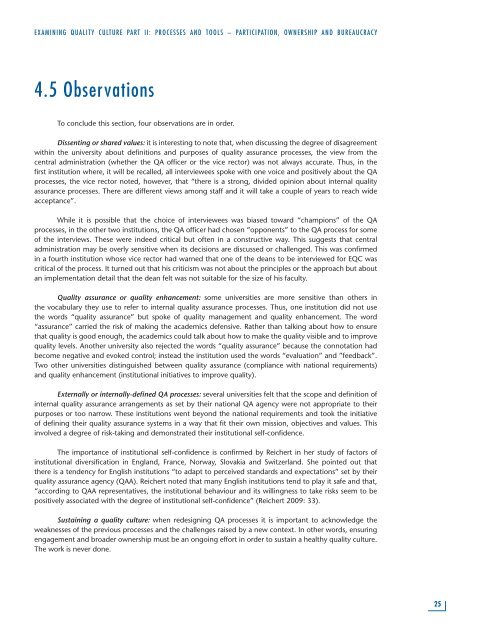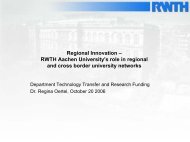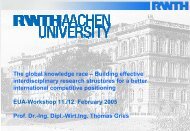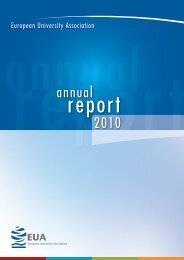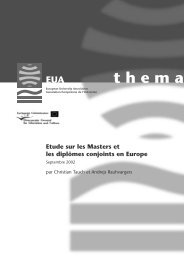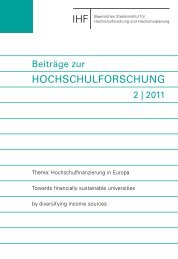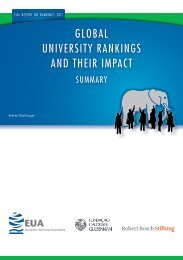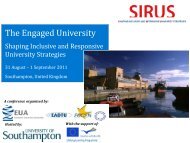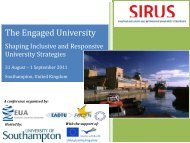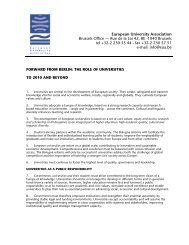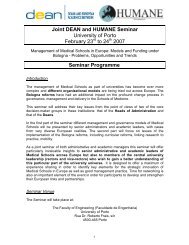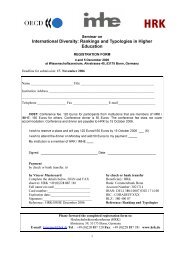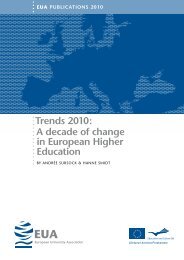Examining Quality Culture Part II: - European University Association
Examining Quality Culture Part II: - European University Association
Examining Quality Culture Part II: - European University Association
You also want an ePaper? Increase the reach of your titles
YUMPU automatically turns print PDFs into web optimized ePapers that Google loves.
ExAmININg QUALITy CULTUrE PArT <strong>II</strong>: PrOCESSES ANd TOOLS – PArTICIPATION, OwNErShIP ANd BUrEAUCrACy<br />
4.5 Observations<br />
To conclude this section, four observations are in order.<br />
Dissenting or shared values: it is interesting to note that, when discussing the degree of disagreement<br />
within the university about definitions and purposes of quality assurance processes, the view from the<br />
central administration (whether the QA officer or the vice rector) was not always accurate. Thus, in the<br />
first institution where, it will be recalled, all interviewees spoke with one voice and positively about the QA<br />
processes, the vice rector noted, however, that “there is a strong, divided opinion about internal quality<br />
assurance processes. There are different views among staff and it will take a couple of years to reach wide<br />
acceptance”.<br />
While it is possible that the choice of interviewees was biased toward “champions” of the QA<br />
processes, in the other two institutions, the QA officer had chosen “opponents” to the QA process for some<br />
of the interviews. These were indeed critical but often in a constructive way. This suggests that central<br />
administration may be overly sensitive when its decisions are discussed or challenged. This was confirmed<br />
in a fourth institution whose vice rector had warned that one of the deans to be interviewed for EQC was<br />
critical of the process. It turned out that his criticism was not about the principles or the approach but about<br />
an implementation detail that the dean felt was not suitable for the size of his faculty.<br />
<strong>Quality</strong> assurance or quality enhancement: some universities are more sensitive than others in<br />
the vocabulary they use to refer to internal quality assurance processes. Thus, one institution did not use<br />
the words “quality assurance” but spoke of quality management and quality enhancement. The word<br />
“assurance” carried the risk of making the academics defensive. Rather than talking about how to ensure<br />
that quality is good enough, the academics could talk about how to make the quality visible and to improve<br />
quality levels. Another university also rejected the words “quality assurance” because the connotation had<br />
become negative and evoked control; instead the institution used the words “evaluation” and ”feedback”.<br />
Two other universities distinguished between quality assurance (compliance with national requirements)<br />
and quality enhancement (institutional initiatives to improve quality).<br />
Externally or internally-defined QA processes: several universities felt that the scope and definition of<br />
internal quality assurance arrangements as set by their national QA agency were not appropriate to their<br />
purposes or too narrow. These institutions went beyond the national requirements and took the initiative<br />
of defining their quality assurance systems in a way that fit their own mission, objectives and values. This<br />
involved a degree of risk-taking and demonstrated their institutional self-confidence.<br />
The importance of institutional self-confidence is confirmed by Reichert in her study of factors of<br />
institutional diversification in England, France, Norway, Slovakia and Switzerland. She pointed out that<br />
there is a tendency for English institutions “to adapt to perceived standards and expectations” set by their<br />
quality assurance agency (QAA). Reichert noted that many English institutions tend to play it safe and that,<br />
“according to QAA representatives, the institutional behaviour and its willingness to take risks seem to be<br />
positively associated with the degree of institutional self-confidence” (Reichert 2009: 33).<br />
Sustaining a quality culture: when redesigning QA processes it is important to acknowledge the<br />
weaknesses of the previous processes and the challenges raised by a new context. In other words, ensuring<br />
engagement and broader ownership must be an ongoing effort in order to sustain a healthy quality culture.<br />
The work is never done.<br />
25


